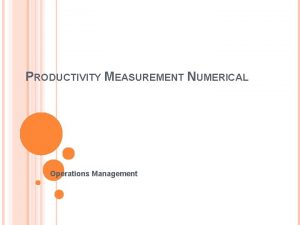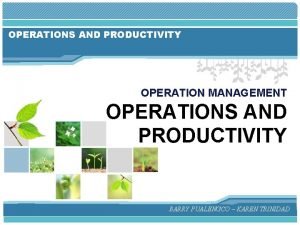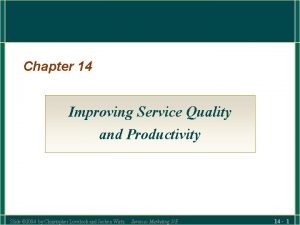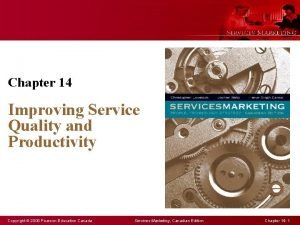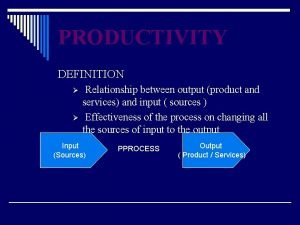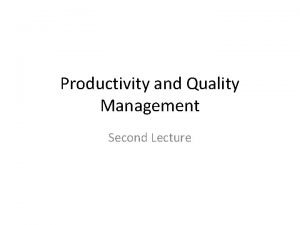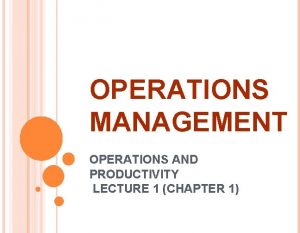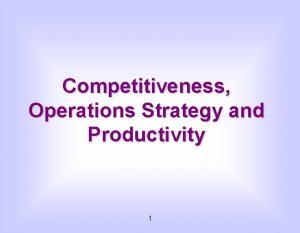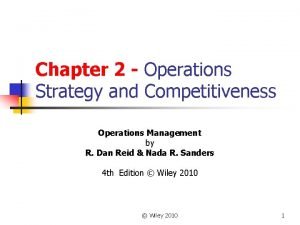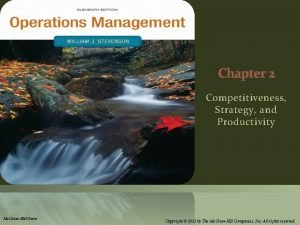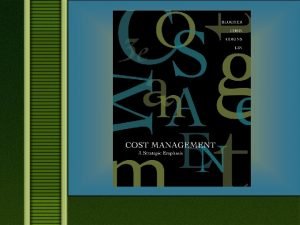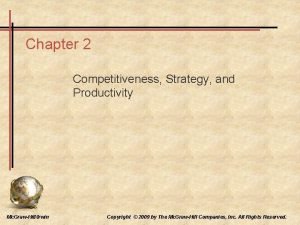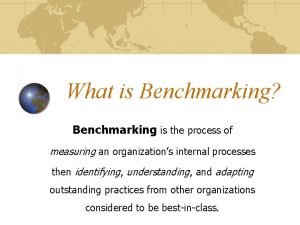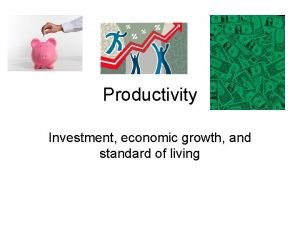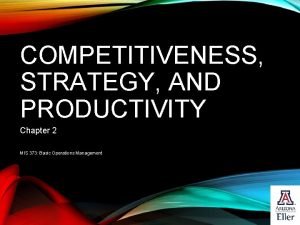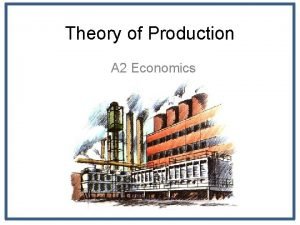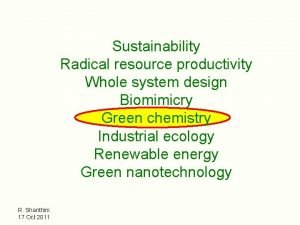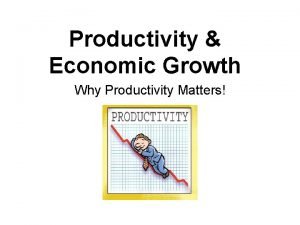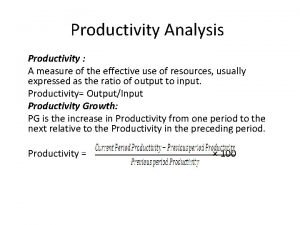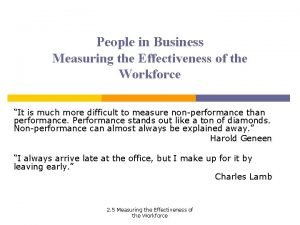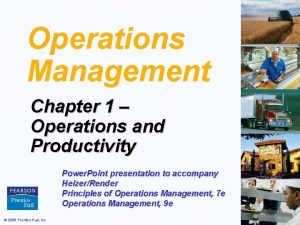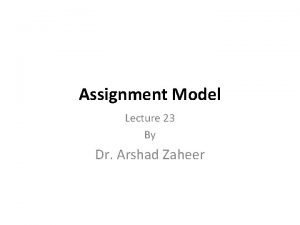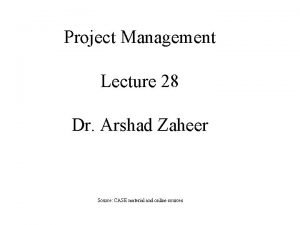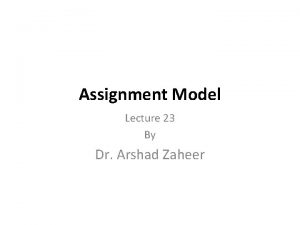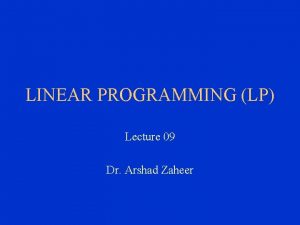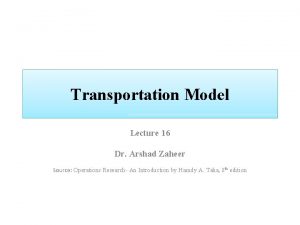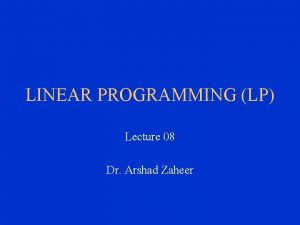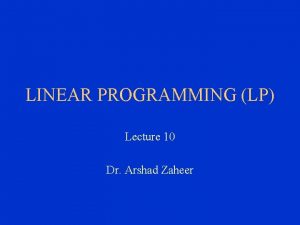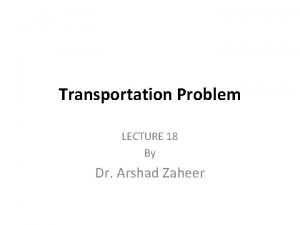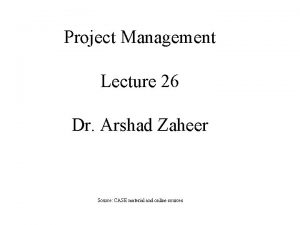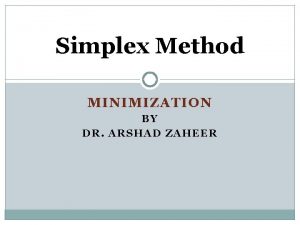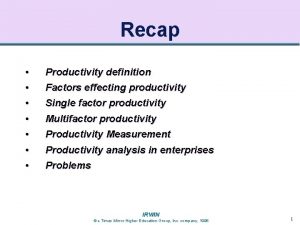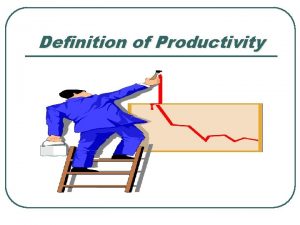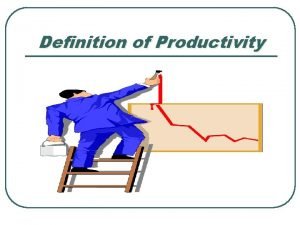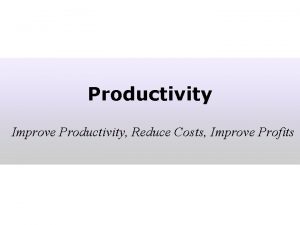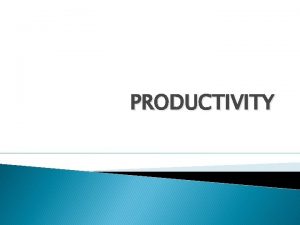Lecture 2 Productivity and Measurement Dr Arshad Zaheer












































- Slides: 44

Lecture 2 Productivity and Measurement Dr. Arshad Zaheer

Recap • • Management • • Value-Added • • Definition of Operations Management • • Goods and Services • New Trends in OM Operations Interfaces Nomenclature Responsibilities of Operations Manager

Lecture Outline • • Productivity definition • • Single factor productivity • • Productivity Measurement Productivity analysis in enterprises • Problems Factors effecting productivity Multifactor productivity

Productivity Challenge Productivity is the ratio of outputs (goods and services) divided by the inputs (resources such as labor and capital) The objective is to improve productivity! Important Note! Production is a measure of output only and not a measure of efficiency

Factors Affecting Productivity Capital Quality Technology Management

Productivity Units produced Productivity = Input used þ Measure of process improvement þ Represents output relative to input þ Only through productivity increases can our standard of living improve • How can we improve? • Labor, Technology, Management

Productivity Calculations Labor Productivity Units produced Productivity = Labor-hours used 1, 000 = = 4 units/labor-hour 250 One resource input single-factor productivity

Multi-Factor Productivity Output Productivity = Labor + Material + Energy + Capital + Miscellaneous þ Also known as total factor productivity Multiple resource inputs multi-factor productivity

Labor Productivity At national level: Labor productivity- computed by taking entire economically active population as input Total value of goods & services produced as output. National productivity = GNP Population 9

Productivity Measurement is important for productivity improvement. Very effective tool for decision-making at all economic levels. Success of productivity measurement & analysis depends largely upon clear understanding by all parties concerned (enterprise managers, worker, employers, trade union orgs & government; institutions) of why productivity measurement is important for effectiveness of org. 10

Productivity Analysis in Enterprise Simple & practical approaches productivity analysis are: to Measurement of workers productivity Measurement systems for planning & analyzing unit labor requirements. Measurement system of labor productivity aimed at structure of labor resource use. Value added productivity at enterprise level.

Productivity Analysis in Enterprise. Three of most common purpose are: Comparing enterprise with its competitors. Determining relative performance departments & workers of Comparing relative benefits of various types of input for collective bargaining & gain sharing.

Collins Title Productivity Collins title wants to evaluate its labor and multifactor productivity with a new computerized title-search system. The company has a staff of four, each working eight hours per day (for a payroll of cost of $640/day) and overhead expenses of 400$ per day. Collins processes and closes on eight titles each day. The new computerized title-search system will allow the processing of 14 titles per day. Although the staff, their work hours and pay are the same, the overhead expenses are now 800$ per day. What is the labor productivity and multifactor productivity with old and new system?

Collins Title Productivity Old System: Staff of 4 works 8 hrs/day Payroll cost = $640/day 8 titles/day Old labor = productivity 32 labor-hrs 8 titles/day Overhead = $400/day

Collins Title Productivity Old System: Staff of 4 works 8 hrs/day Payroll cost = $640/day 8 titles/day Overhead = $400/day 8 titles/day Old labor = productivity 32 labor-hrs =. 25 titles/labor-hr

Collins Title Productivity Old System: Staff of 4 works 8 hrs/day Payroll cost = $640/day New System: 14 titles/day 8 titles/day Overhead = $400/day Overhead = $800/day 8 titles/day Old labor = productivity 32 labor-hrs =. 25 titles/labor-hr 14 titles/day New labor = productivity 32 labor-hrs

Collins Title Productivity Old System: Staff of 4 works 8 hrs/day Payroll cost = $640/day New System: 14 titles/day 8 titles/day Overhead = $400/day Overhead = $800/day 8 titles/day Old labor = productivity 32 labor-hrs =. 25 titles/labor-hr 14 titles/day New labor = =. 4375 titles/labor-hr productivity 32 labor-hrs

Collins Title Productivity Old System: Staff of 4 works 8 hrs/day Payroll cost = $640/day New System: 14 titles/day 8 titles/day Overhead = $400/day Overhead = $800/day 8 titles/day Old multifactor = productivity $640 + 400

Collins Title Productivity Old System: Staff of 4 works 8 hrs/day Payroll cost = $640/day New System: 14 titles/day 8 titles/day Overhead = $400/day Overhead = $800/day 8 titles/day Old multifactor = =. 0077 titles/dollar productivity $640 + 400

Collins Title Productivity Old System: Staff of 4 works 8 hrs/day Payroll cost = $640/day New System: 14 titles/day 8 titles/day Overhead = $400/day Overhead = $800/day 8 titles/day Old multifactor = =. 0077 titles/dollar productivity $640 + 400 14 titles/day New multifactor = productivity $640 + 800

Collins Title Productivity Old System: Staff of 4 works 8 hrs/day Payroll cost = $640/day New System: 14 titles/day 8 titles/day Overhead = $400/day Overhead = $800/day 8 titles/day Old multifactor = =. 0077 titles/dollar productivity $640 + 400 14 titles/day New multifactor = =. 0097 titles/dollar productivity $640 + 800

Measurement Problems þ Quality may change while the quantity of inputs and outputs remains constant þ External elements may cause an increase or decrease in productivity þ Precise units of measure may be lacking

Productivity Variables þ Labor - contributes about 10% of the annual increase þ Capital - contributes about 38% of the annual increase þ Management contributes about 52% of the annual increase

Problem 1 The Production Manager at a Textile Mills, can currently expect his operation to produce 1000 square yards of fabric for each ton of raw cotton. Each ton of raw cotton requires 5 labor hours to process. He believes that he can buy a better quality raw cotton, which will enable him to produce 1200 square yards per ton of raw cotton with the same labor hours. What will be the impact on productivity (measured in square yards per labor-hour) if he purchases the higher quality raw cotton?

Solution 1000 sq yds Current Labor = 200 sq yds per hour = Productivity 1 ton * 5 hours New Labor Productivity 1200 sq yds = 240 sq yards per hour = 1 ton * 5 hours Productivity improves 20%= (240 -200) / 200 = 0. 2 (20%)

Problem 2 A local auto mechanic finds that it usually takes him 2 hours to diagnose and fix a typical problem. What is his daily productivity (assume an 8 hour day)? He believes he can purchase a small computer trouble-shooting device, which will allow him to find and fix a problem in the incredible (at least to his customers!) time of 1 hour. He will, however, have to spend an extra hour each morning adjusting the computerized diagnostic device. What will be the impact on his productivity if he purchases the device?

Solution 8 hours per day Current Productivity = 2 hours per problem = 4 Problems per day Productivity 8 hours per day = 7 Problems per day = with computer 2 hours per problem Productivity improves 75% (7 -4) / 4 = 0. 75 (75%)

Problem 3 Susan has a part-time "cottage industry" producing seasonal plywood yard ornaments for resale at local craft fairs and bazaars. She currently works 8 hours per day to produce 16 ornaments. a. What is her productivity? b. She thinks that by redesigning the ornaments and switching from use of a wood glue to a hot-glue gun she can increase her total production to 20 ornaments per day. What is her new productivity? c. What is her percentage increase in productivity?

Solution a. 16 ornaments/8 hours = 2 ornaments/hour b. 20 ornaments/8 hours = 2. 5 ornaments/hour c. Change in productivity = 0. 5 ornaments/hour; percent change = 0. 5/2= 25%

Problem 4 A firm cleans chemical tank cars. With standard equipment, the firm typically cleaned 70 chemical tank cars per month. They utilized 10 gallons of solvent, and two employees worked 20 days per month, 8 hours a day. The company decided to switch to a larger cleaning machine. Last April, they cleaned 60 tank cars in only 15 days. They utilized 12 gallons of solvent, and the two employees worked 6 hours a day. 1. What was their productivity with the standard equipment? 2. What is their productivity with the larger machine? 3. What is the change in productivity?

Solution

Problem 5 Joanna French is currently working a total of 12 hours per day to produce 240 dolls. She thinks that by changing the paint used for the facial features and fingernails that she can increase her rate to 360 dolls per day. Total material cost for each doll is approximately $3. 50; she has to invest $20 in the necessary supplies (expendables) per day; energy costs are assumed to be only $4. 00 per day; and she thinks she should be making $10 per hour for her time. Viewing this from a total (multifactor) productivity perspective, what is her productivity at present and with the new paint?

Solution Currently Labor Material Using the new paint 12 hrs * $10 = $120 12 hrs * $10 = $ 120 240 * $3. 50 = $840 360 * $3. 50 = $1260 Supplies = $ 20 =$ 20 Energy =$ =$ 4 Total Inputs = $984 Productivity 240/984 = 0. 24 4 = $1404 360/1404 =. 26

Problem 6 (Refer Problem 5) How would total (multifactor) productivity change if using the new paint raised Ms. French’s material costs by $0. 50 per doll?

Solution If the material costs increase by $0. 5 per doll: Using the new paint Labor Material 12 hrs * $10 = $ 120 360 * $4 = $1440 Supplies =$ 20 Energy =$ 4 Total Inputs = $1584 Productivity 360/1584 =. 23

Problem 7 (Refer Problem 6) If she uses the new paint, by what amount could Ms. French’s material costs increase keeping the total (multifactor) productivity same as 0. 24?

Solution We want to know high the material cost could go, using the new paint, before the productivity drops to the current level of 0. 24. In mathematical terms we make the material cost a variable (X), set the new multifactor productivity value to the current level, 0. 24, and solve for X. 360 (12 x 10) + (360 X) + 20 +4 = 0. 24 360= 0. 24(120 + 360 X + 20 + 4 360= 28. 8 + 86. 4 X + 4. 8 + 0. 96 X =3. 77 $ It follows then that the new paint could raise Materials cost by no more than approximately $0. 27 (the difference between $3. 77 and $3. 50) before Ms. French would experience a decrease in multifactor productivity.

Problem 8

Solution (a) Total output is 1600 valves per day. 20 workers are active for eight hours per day. So Total working hours per day are 20 x 8=160. So Labor Productivity is 1600/160 i. e. 10 valves/hour. (b) Productivity rises by 20 percent, to 12 valves/hour. output will be 12 x 8 x 20 = 1920 (c) New productivity is 1800 / (20 x 8) = 11. 25 valves/hour (d) Gibson did not gain the desired 20 percent increase in productivity, but they did gain over ten percent, without extra equipment or energy, and without increasing the wage bill.

Problem 9

Solution MFP before: 500 boxes / ($10 x 5 x 16 + $3000 + $400) = 500 / 4200 = 0. 119 boxes/dollar MFP after: 600 boxes / ($10 x 5 x 16 + $3200 + $400) = 600 / 4400 = 0. 136 boxes/dollar

Problem 10 A farmer grows crop in his 100 by 100 foot garden. He then sells the crop at the local farmers' market. Two summers ago, he was able to produce and sell 1200 pounds of crop. Last summer, he tried a new fertilizer that promised a 50% increase in yield. He harvested 1900 pounds. Did the fertilizer live up to its promise?

Solution Two summer ago 1200/10000=0. 12 lbs/sq ft Last Sumer 1900/10000=0. 19 lbs/sq ft Change (0. 19 - 0. 12)/0. 12 = 58. 3% Since the productivity gain was 58. 3%, not 50%, the fertilizer was at least as good as advertised.

Forthcoming lecture- Competitiveness and Strategy
 Sri zaheer
Sri zaheer Zaheer qazi
Zaheer qazi Zaheer ayub baig
Zaheer ayub baig Multifactor productivity in operations management
Multifactor productivity in operations management Dr arshad ejazi
Dr arshad ejazi Reactive airways dysfunction syndrome
Reactive airways dysfunction syndrome Dr syed arshad
Dr syed arshad New kuwait
New kuwait Arshad mansoor
Arshad mansoor Arshad habib
Arshad habib Arshad usmani
Arshad usmani Dr arshad ali khan
Dr arshad ali khan 01:640:244 lecture notes - lecture 15: plat, idah, farad
01:640:244 lecture notes - lecture 15: plat, idah, farad Productivity operations management
Productivity operations management Productivity and competitiveness in operations management
Productivity and competitiveness in operations management Improving service quality and productivity ppt
Improving service quality and productivity ppt Service quality and productivity
Service quality and productivity Relationship between safety, quality and productivity
Relationship between safety, quality and productivity Output/product
Output/product Define productivity
Define productivity The ten critical decisions of operations management include
The ten critical decisions of operations management include Nutrition and productivity
Nutrition and productivity Human language displacement
Human language displacement Scale based strategy
Scale based strategy Productivity and competitiveness in operations management
Productivity and competitiveness in operations management Competitiveness strategy and productivity
Competitiveness strategy and productivity Managing productivity and marketing effectiveness
Managing productivity and marketing effectiveness Operation and productivity chapter 1
Operation and productivity chapter 1 Chapter 2 competitiveness strategy and productivity
Chapter 2 competitiveness strategy and productivity Benchmarking lets an organization
Benchmarking lets an organization Productivity and standard of living
Productivity and standard of living Lam employment absence and productivity scale
Lam employment absence and productivity scale Competitiveness strategy and productivity
Competitiveness strategy and productivity Progress and performance measurement and evaluation
Progress and performance measurement and evaluation Progress and performance measurement and evaluation
Progress and performance measurement and evaluation The law of diminishing marginal productivity
The law of diminishing marginal productivity Mission control productivity
Mission control productivity Cradle to cradle design
Cradle to cradle design Steiners model of group effectiveness
Steiners model of group effectiveness Fundamentals of input and output performance
Fundamentals of input and output performance Why productivity matters
Why productivity matters Partial operational productivity ratio
Partial operational productivity ratio Labour productivity formula
Labour productivity formula Labor productivity formula
Labor productivity formula Collins title productivity
Collins title productivity



